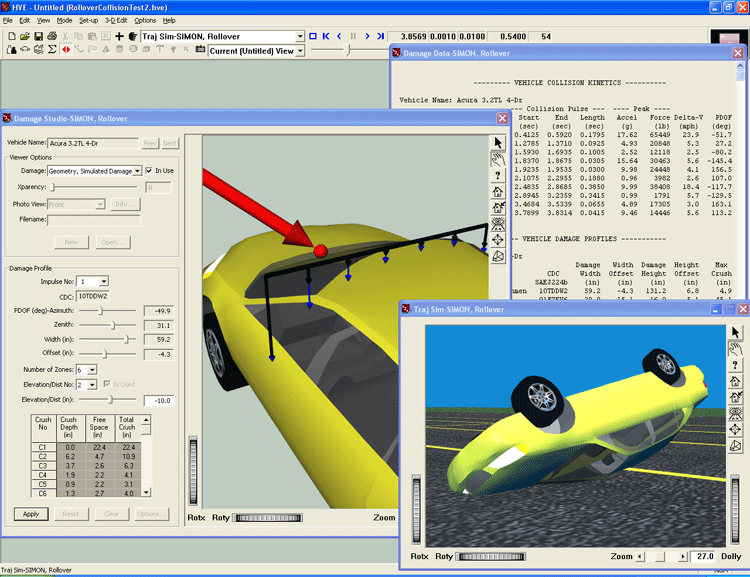![]() DamageStudio ®
DamageStudio ®
DamageStudio is a graphical analysis tool that allows the user to visualize collision data from an EDSMAC4 or SIMON/DyMESH simulation, and to correlate collision damage with the kinetics (force magnitude and direction), delta-V, acceleration and other important collision parameters. The Damage Data output report (Collision Data format) provides results including the familiar Damage Width, Damage Offset and Crush Depth Table (C1, C2, etc.), measurements for the simulated crush profile.
There are many uses for the kind of detailed collision information provided by DamageStudio. One example is the ability to directly compare simulated crush dimensions with a measured damage profile. This technique can also be used to fine-tune stiffness coefficients from staged collision data. DamageStudio can also be used to identify the magnitude and direction of individual impulses, peak collision forces and delta-Vs for vehicles undergoing multiple impacts, even if the impacts are simultaneous.
DamageStudio is an option available in the HVE Playback Editor that replaces the Damage Profiles output report. A DamageStudio window includes a 3-D viewer and two groups of supporting information: Viewer Options and Damage Profile. These two new features differentiate DamageStudio from HVE's existing Damage Profile output report window.
When the Viewer Option for Simulated Damage is selected, the 3-D viewer displays the vehicle damage calculated by the simulation. As the simulation is played, the damage profile dynamically updates, showing the current damage profile. DamageStudio also displays the PDOF, impulse center and color-coded crush vectors showing free space and actual crush depth. The DamageStudio viewer also includes a Key Results window that displays time-domain collision results for each impulse. These Key Results include time, impulse number, velocity, acceleration, delta-V, PDOF, force and several more. Like other Key Results windows, the list is added to or removed from the viewer by clicking the Show Key Results option in the Options menu.
For simulated vehicle damage, the Damage Profile group displays the current impulse number (up to 10 individual impulses per vehicle may be displayed), along with the following results for the current impulse: Collision Deformation Classification (CDC), 3-dimensional PDOF, Width, Offset, Elevation/Distance and Crush Table.

- Simulated Damage - Selecting this option displays the vehicle damage calculated by the simulation.
- User-entered Damage - Selecting this option displays a vehicle dimensions "shoe-box" and user-entered damage dimensions (an extended version of the Damage Profiles dialog currently used in the Event Editor for supplying damage dimensions for an EDCRASH event).
- Undamaged - Selecting this option displays the original (undamaged) vehicle geometry for comparison with the damaged vehicle.
- Geometry, From File - Selecting this option displays any 3-D model provided by the user. The user would typically select, using a file browser, a CAD model that was created from a scan or total station survey of the actual crash vehicle.
- Damage Photograph - Selecting this option displays up to seven user-supplied vehicle damage photographs (six orthographic, one perspective). The user would typically select, using a file browser, one or more photographs that document the damage profile of the actual crash vehicle.
DamageStudio, Damage Data (Collision Data format) and Trajectory Simulation results can be used together to provide extremely detailed information about a collision. You can correlate collision forces and accelerations directly with crush information and occupant injury. You can determine the time of peak forces and accelerations and correlate those with vehicle orientation and occupant position within a vehicle. In multiple vehicle collisions (yes, they may be simultaneous), you can identify which collision produced the greatest force and associated crush.
The Technical Session of the Summer 2010 EDC Technical Newsletter presented an overview of DamageStudio and also an example using DamageStudio to analyze a rollover collision. Dedicated chapters in the HVE Users Manual are also available to support users in their interpretation and understanding of the detailed results provided by DamageStudio.
